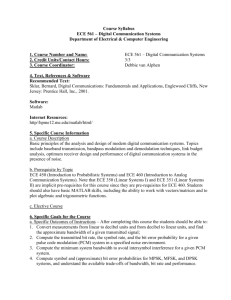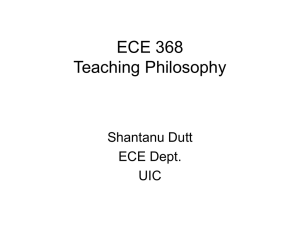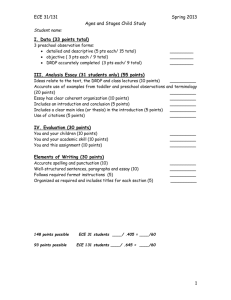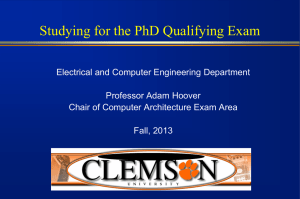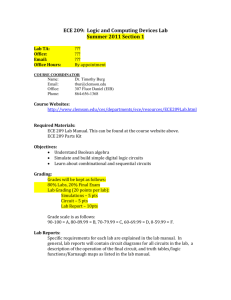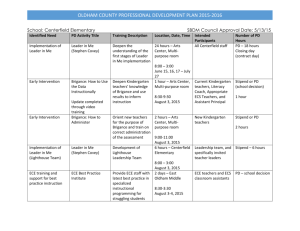FORMAT 1B - Submit original with signatures only
advertisement
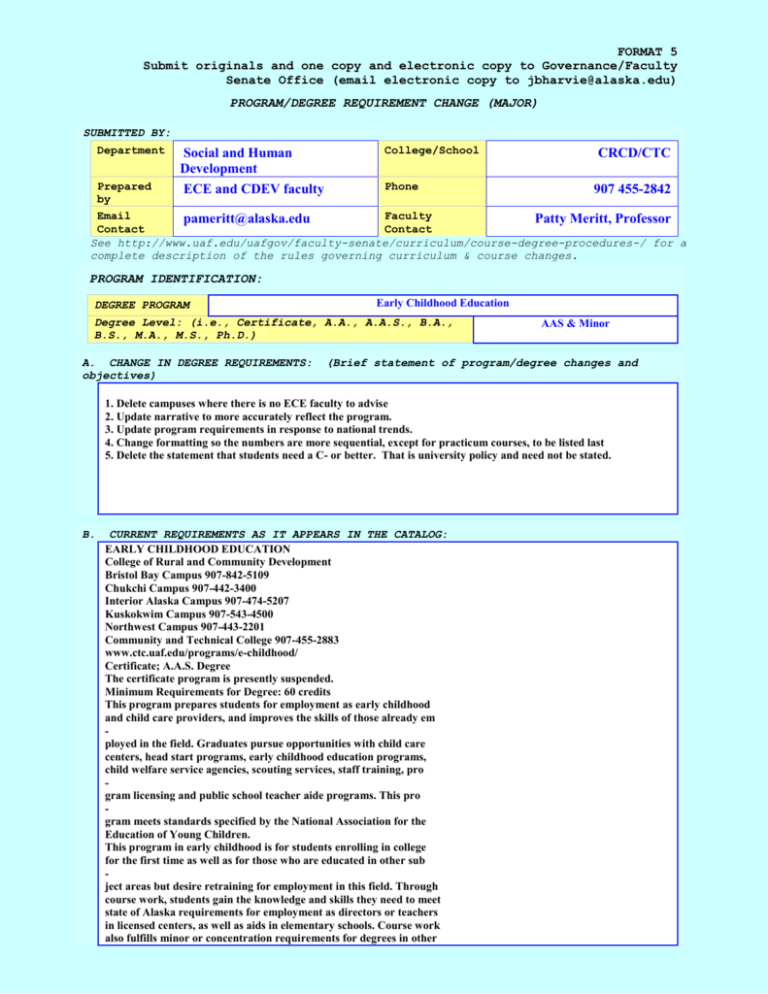
FORMAT 5 Submit originals and one copy and electronic copy to Governance/Faculty Senate Office (email electronic copy to jbharvie@alaska.edu) PROGRAM/DEGREE REQUIREMENT CHANGE (MAJOR) SUBMITTED BY: Department Prepared by Social and Human Development ECE and CDEV faculty College/School Phone CRCD/CTC 907 455-2842 Email Faculty pameritt@alaska.edu Patty Meritt, Professor Contact Contact See http://www.uaf.edu/uafgov/faculty-senate/curriculum/course-degree-procedures-/ for a complete description of the rules governing curriculum & course changes. PROGRAM IDENTIFICATION: DEGREE PROGRAM Early Childhood Education Degree Level: (i.e., Certificate, A.A., A.A.S., B.A., B.S., M.A., M.S., Ph.D.) A. CHANGE IN DEGREE REQUIREMENTS: objectives) AAS & Minor (Brief statement of program/degree changes and 1. Delete campuses where there is no ECE faculty to advise 2. Update narrative to more accurately reflect the program. 3. Update program requirements in response to national trends. 4. Change formatting so the numbers are more sequential, except for practicum courses, to be listed last 5. Delete the statement that students need a C- or better. That is university policy and need not be stated. B. CURRENT REQUIREMENTS AS IT APPEARS IN THE CATALOG: EARLY CHILDHOOD EDUCATION College of Rural and Community Development Bristol Bay Campus 907-842-5109 Chukchi Campus 907-442-3400 Interior Alaska Campus 907-474-5207 Kuskokwim Campus 907-543-4500 Northwest Campus 907-443-2201 Community and Technical College 907-455-2883 www.ctc.uaf.edu/programs/e-childhood/ Certificate; A.A.S. Degree The certificate program is presently suspended. Minimum Requirements for Degree: 60 credits This program prepares students for employment as early childhood and child care providers, and improves the skills of those already em ployed in the field. Graduates pursue opportunities with child care centers, head start programs, early childhood education programs, child welfare service agencies, scouting services, staff training, pro gram licensing and public school teacher aide programs. This pro gram meets standards specified by the National Association for the Education of Young Children. This program in early childhood is for students enrolling in college for the first time as well as for those who are educated in other sub ject areas but desire retraining for employment in this field. Through course work, students gain the knowledge and skills they need to meet state of Alaska requirements for employment as directors or teachers in licensed centers, as well as aids in elementary schools. Course work also fulfills minor or concentration requirements for degrees in other disciplines. Students entering the A.A.S. degree should meet with an early childhood advisor to discuss a specific course of study. The required early childhood courses offered by any of the UAF campus sites may be used to meet graduation requirements for the degree. The courses for the A.A.S. degree lay the foundation for the B.A. in child development and family studies. Major — A.A.S. Degree 1. Complete the general university requirements ( page 93 ). 2. Complete the A.A.S. degree requirements. (See page 97 . As part of the A.A.S. degree requirement, complete ECE F117 or any course at the F100 level or above in mathematical sciences for the computation requirement, and ECE F107 for the human relations requirement.) 3. Complete the following:* ECE F101—Introduction to Early Childhood Profession ................... 3 ECE F104—Child Development I: Prenatal, Infants and Toddlers ... 3 ECE F110—Safe, Healthy, Learning Environments ............................ 3 ECE F119—Curriculum I: Principles and Practices ............................ 3 ECE F213—Curriculum II: Thinking, Reasoning and Discovering (3) or ECE F214—Curriculum III: Infants and Toddlers (3) ............... 3 ECE F229—Foundations in Nutrition and Physical Wellness ........... 3 ECE F140—Positive Social and Emotional Development .................. 3 ECE F170—Practicum I (3) or ECE F115—Responsive and Reflective Teaching (3) or ECE F299—Practicum for CDAs (3) ............................................. 3 ECE F210—Child Guidance ................................................................... 3 ECE F235—Screening, Assessment and Recording ............................ 2 ECE F230—Introduction to Children with Special Needs (3) or ECE F240—Inclusion of Children with Special Needs (3) ........ 3 ECE F242—Child and Family Ecology (3) or ECE F342—Family Relationships (3) or other advisor-approved family class ............................................. 3 ECE F270—Practicum II ......................................................................... 3 4. Complete 7 credits as designated by an ECE advisor/coordinator .... 7 5. Minimum credits required ................................................................... 60 * Students must earn a C- grade or better in each course. C. PROPOSED REQUIREMENTS AS IT WILL APPEAR IN THE CATALOG WITH THESE CHANGES: (Underline new wording strike through old wording and use complete catalog format ) EARLY CHILDHOOD EDUCATION College of Rural and Community Development 888-560-5860 Community and Technical College 907-455-2883 www.ctc.uaf.edu/programs/e-childhood/ Bristol Bay Campus 907-842-5109 Chukchi Campus 907-442-3400 Interior Alaska Campus 907-474-5207 Kuskokwim Campus 907-543-4500 Northwest Campus 907-443-2201 Community and Technical College 907-455-2883 www.ctc.uaf.edu/programs/e-childhood/ Certificate; A.A.S. Degree The certificate program is presently suspended. Minimum Requirements for Degree: 60 credits All courses are offered in Fairbanks as well as through distance delivery for students outside Fairbanks. This program prepares students for employment as early childhood teachers, K-3 teacher aides, and child care providers, and improves the skills of those already em ployed in the field. Graduates pursue opportunities with child development care centers, head start Head Start programs, early childhood education programs, child welfare service agencies, recreation and scouting services, staff training, pro gram licensing and public school teacher aide programs entrepreneurial initiatives serving children and families. This pro gram meets standards specified by the National Association for the Education of Young Children. This The AAS program in early childhood Early Childhood Education is for students enrolling in college for the first time as well as for those who are educated in other sub ject areas but desire retraining for employment in this field. Through course work, including field work directly with children, students gain the knowledge and skills they need to meet state of Alaska requirements for employment as directors administrators or teachers in licensed centers, as well as aids in elementary schools. Course work also fulfills minor or concentration requirements for degrees in other disciplines. Students entering the A.A.S. degree should meet with an early childhood advisor to discuss a specific course of study. The required early childhood courses offered by any of the UAF campus sites may be used to meet graduation requirements for the degree. The courses for the A.A.S. degree lay the foundation for the B.A. in child development and family studies Child Development and Family Studies or can be combined with other disciplines to make specific focus on young children in areas such as science, movement, leadership, business or creative arts. Major — A.A.S. Degree 1. Complete the general university requirements ( page 93 ). 2. Complete the A.A.S. degree requirements. (See page 97 . As part of the A.A.S. degree requirement, complete ECE F117 or any course at the F100 level or above in mathematical sciences for the computation requirement, and ECE F107 for the human relations requirement.) 3. Complete the following:* ECE F101—Introduction to Early Childhood Profession ................... 3 ECE F104—Child Development I: Prenatal, Infants and Toddlers ... 3 ECE F110—Safe, Healthy, Learning Environments ............................ 3 ECE F119—Curriculum I: Principles and Practices ............................ 3 ECE F130—Culture Learning and the Young Child (2) ECE 132 Young Child & the Family (1) Or LS 101 Library Science Class (1) ECE F140—Positive Social and Emotional Development .................. 3 ECE F210—Child Guidance ................................................................... 3 ECE F213—Curriculum II: Thinking, Reasoning and Discovering (3) or ECE F214—Curriculum III: Infants and Toddlers (3) ............... 3 ECE F229—Foundations in Nutrition and Physical Wellness ........... 3 ECE F140—Positive Social and Emotional Development .................. 3 ECE F170—Practicum I (3) or ECE F115—Responsive and Reflective Teaching (3) or ECE F299—Practicum for CDAs (3) ............................................. 3 ECE F210—Child Guidance ................................................................... 3 ECE F229—Foundations in Nutrition and Physical Wellness ........... 3 ECE F235—Screening, Assessment and Recording ............................ 2 (3) ECE F230—Introduction to Children with Special Needs (3) or ECE F240—Inclusion of Children with Special Needs (3) ........ 3 ECE F242—Child and Family Ecology (3) or ECE F342—Family Relationships (3) or other advisor-approved family class ............................................. 3 ECE F170—Practicum I (3) or ECE F299—Practicum for CDAs (3) ............................................. 3 ECE F270—Practicum II ......................................................................... 3 4. Complete 7 credits as designated by an ECE advisor/coordinator .... 7 5. 4. Minimum credits required ................................................................... 60 *Students must earn a C- grade or better in each course. The completed changes should read as follows, except be formatted to fit the catalog: EARLY CHILDHOOD EDUCATION College of Rural and Community Development 888-560-5860 Community and Technical College 907-455-2883 www.ctc.uaf.edu/programs/e-childhood/ Kuskokwim Campus 907-543-4500 Certificate; A.A.S. Degree The certificate program is presently suspended. Minimum Requirements for Degree: 60 credits All courses are offered in Fairbanks as well as through distance delivery for students outside Fairbanks. This program prepares students for employment as early childhood teachers, K-3 teacher aides, and child care providers, and improves the skills of those already employed in the field. Graduates pursue opportunities with child development centers, Head Start programs, child welfare service agencies, recreation and scouting services, staff training, program licensing and entrepreneurial initiatives serving children and families. This program is guided by standards specified by the National Association for the Education of Young Children. The AAS program in Early Childhood Education is for students enrolling in college for the first time as well as for those who are educated in other subject areas but desire retraining for employment in this field. Through course work, including field work directly with children, students gain the knowledge and skills they need to meet state of Alaska requirements for employment as administrators or teachers in licensed centers, as well as aids in elementary schools. Course work also fulfills minor or concentration requirements for degrees in other disciplines. Students entering the A.A.S. degree should meet with an early childhood advisor to discuss a specific course of study. The courses for the A.A.S. degree lay the foundation for the B.A. in Child Development and Family Studies or can be combined with other disciplines to make specific focus on young children in areas such as science, movement, leadership, business or creative arts. Major — A.A.S. Degree 1. Complete the general university requirements (page 93). 2. Complete the A.A.S. degree requirements. (See page 97. As part of the A.A.S. degree requirement, complete ECE F117 or any course at the F100 level or above in mathematical sciences for the computation requirement, and ECE F107 for the human relations requirement.) 3. Complete the following:* ECE F101—Introduction to Early Childhood Profession....................3 ECE F104—Child Development I: Prenatal, Infants and Toddlers.....3 ECE F110—Safe, Healthy, Learning Environments...........................3 ECE F119—Curriculum I: Principles and Practices............................3 ECE F130—Culture Learning and the Young Child ………………..2 ECE 132 Young Child & the Family ………………………………..1 Or LS 101 Library Science Class (1) ECE F140—Positive Social and Emotional Development..................3 ECE F210—Child Guidance................................................................3 ECE F213—Curriculum II: Thinking, Reasoning and Discovering …3 ECE F214—Curriculum III: Infants and Toddlers .............................3 ECE F229—Foundations in Nutrition and Physical Wellness...........3 ECE F235—Screening, Assessment and Recording...........................3 ECE F240—Inclusion of Children with Special Needs .....................3 ECE F242—Child and Family Ecology.............................................3 or ECE F342—Family Relationships (3) or other advisor-approved family class (3) ECE F170—Practicum I .............................................................. 3 or ECE F299—Practicum for CDAs (3) ECE F270—Practicum II...............................................................3 4.Minimum credits required.........................................................60 D. ESTIMATED IMPACT WHAT IMPACT, IF ANY, WILL THIS HAVE ON BUDGET, FACILITIES/SPACE, FACULTY, ETC. Very little fiscal impact; increased efficiency may save time more than money. Reduce staffing efforts. Reduce the need for additional advising for electives. Eliminates the current need for individual memos for each graduate’s approved electives. Takes slightly less space in the catalog. Takes no additional space or facilities. Less confusing for students as it tells exactly where to go for information and clearly outlines the exact requirements. Fewer options means all students will graduate with comparable knowledge and skills. E. IMPACTS ON PROGRAMS/DEPTS: What programs/departments will be affected by this proposed action? Include information on the Programs/Departments contacted (e.g., email, memo) 1. LS may have a few more ECE students. This will be an insignificant number, since it is a comparatively small number of students and many already take the class in their junior year if they go on to a BA program. Also, it is an optional alternative to ECE 132. 2. These changes correctly direct rural students to the rural program advisor, rather than to individual campuses. This is consistent with the current practice, where students work with the rural program rather than individual campuses unless there are full time ECE faculty associated with the campus. 3. ECE and CDEV programs are the ones impacted by the program requirements and the faculty are in agreement that these changes are the right ones for the students at this time. The changes eliminate the “campus based electives” and make the degree consistent for all students. F. IF MAJOR CHANGE - ASSESSMENT OF THE PROGRAM: Description of the student learning outcomes assessment process.) The ECE SLOs are based on the national standards for ECE AAS degree granting institutions. The additional requirement for students to take both ECE 213 and ECE 214 strengthens the Standard 7 regarding field experiences for multiple age groups. In the 2014 SLO document it was pointed out that ECE 130 was not required at all campuses, although it strengthens the program relative to the standard on building family and community relations. Based on faculty input, Advisory Council endorsement and a goal for uniformity across campuses, ECE 130 will now be included for all ECE students. JUSTIFICATION FOR ACTION REQUESTED The purpose of the department and campus-wide curriculum committees is to scrutinize program/degree change applications to make sure that the quality of UAF education is not lowered as a result of the proposed change. Please address this in your response. This section needs to be self-explanatory. If you drop a course, is it because the material is covered elsewhere? Use as much space as needed to fully justify the proposed change and explain what has been done to ensure that the quality of the program is not compromised as a result. In general this request unifies the degree by eliminating the campus based electives and more clearly delineates the expectations for students statewide. 1. Re-ordering the courses makes it easier to separate the 100 and 200 level classes, with both practicum courses at the end. 2. Adding ECE 130 Culture Learning and the Young Child (2 cr) was strongly endorsed by the statewide Advisory Council. This course has been optional, but now all students will benefit from it. 3. Requiring both ECE 213 and ECE 214, instead of allowing them to be a choice, means all ECE AAS students will have experiences with hands on curriculum and learning environments for infants and toddlers as well as preschool children. This is advantageous for Head Start staff and also consistent with the accreditation standards for ECE AAS degree granting institutions. 4. Eliminating the elective credits makes the degree more consistent for all students regardless of campus affiliation, advising or delivery method. This will help with national accreditation. 5. Changing the listing of campuses at the beginning helps direct students to the correct resources for advising. 6. Updating the narrative more accurately informs the students about the program. In summary there are not a lot of substantive changes. There are no new courses. The majority of the students are already following this plan based on advising. In general this request tightens the degree and more clearly delineates the expectations for students statewide. APPROVALS: SIGNATURES MUST BE OBTAINED PRIOR TO SUBMISSION TO THE GOVERNANCE OFFICE Date Signature, Chair, Program/Department of: Date Signature, Chair, College/School Curriculum Council for: Date Signature, Dean, College/School of: CHAIR SIGNATURE OBTAINED FOLLOWING APPROVAL BY FACULTY SENATE COMMITTEE Date Signature, Chair, UAF Faculty Senate ___Curriculum Review Committee ___Graduate Academic and Advisory Committee

